New BioExplorer Deep-State Designs and Alpha-Theta Sounder Program
by Sue Othmer | October 5th, 2006**Bioexplorer Deep-State Designs and Alpha-Theta Sounder is No Longer Available – This is an archived post from 2006
We are releasing a new Alpha-Theta program and three new deep-state designs for BioExplorer. Similar settings files are already available on BrainMaster for use with the EEG Audio program. The Alpha-Theta Sounder program provides audio feedback reflecting alpha and theta amplitudes and the shifting of deep states. The new BioExplorer designs allow one-channel Alpha-Theta with two different displays for the clinician, plus two-channel sum training.
EEGInfo 1 Channel Alpha-Theta
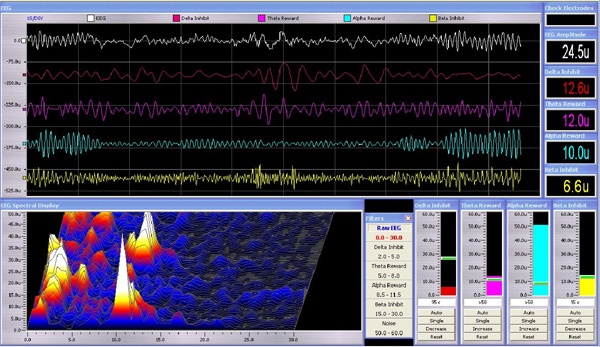
Instruments 1 displays the raw EEG and filtered traces for alpha and theta reward bands, and delta and beta inhibit bands. Rhythmic activity observed in the raw signal can be seen simultaneously in one or more training bands depending on the frequency. Rhythmic activity also shows as a sustained peak in the spectral display. It is interesting to watch shifts in the dominant frequency over time, which can be seen more easily in the spectral display than in the raw EEG. Amplitudes of the raw EEG and training bands are displayed numerically, plus the training band amplitudes are displayed in the threshold bars.
An appropriate electrode placement for one-channel alpha-theta training is Pz-A2 with ground at A1. Default frequency bands are Delta (2-5 Hz), Theta (5-8 Hz), Alpha (8.5-11.5 Hz), Beta (15-30 Hz). The alpha band is chosen to have a center frequency of 10 Hz. This is appropriate and effective for most people. If a person feel groggy or depressed after an alpha-theta session, the alpha band can be raised by one or more Hz so as to leave the person less sedated. Thresholds are set automatically with a continuous autogoal. Alpha and theta background sounds work best when the alpha and theta thresholds are set for the same time over threshold. 40% over threshold for alpha and theta seems to give a good balance of reward sounds. Thresholds are set with a longer time constant than for awake-state training, since we want to allow more gradual and sustained shifts in state. All of the designs support tactile feedback with the Neuroamp. The bear actually vibrates both at 10 Hz with the alpha amplitude and 5 Hz with the theta amplitude. The check electrodes box indicates excess 50-60 Hz noise in the signal, which suggests a poor electrode contact.
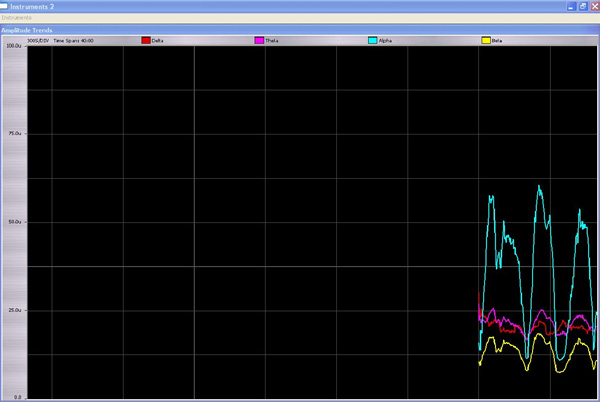
Instruments 2 shows trend lines for the training bands. The default displays a 40-minute session, which can be modified as needed. This is a useful picture of the ongoing session, which may allow recognition of deep state shifts, sleep onset, or arousals and discomfort during the session. All three of the current deep-state designs include the same Instruments 2 display of trend lines, either for one channel of data or for two channels summed.
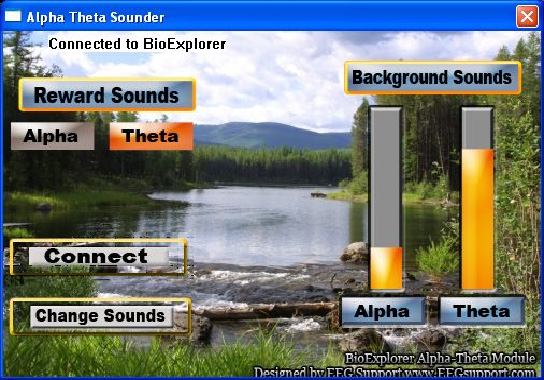
The Alpha-Theta Sounder program produces reward sounds for alpha (chime) and theta (gong) amplitudes over threshold. The theta reward sound will override the alpha chime if both are over threshold. Reward sounds are withheld if inhibit amplitudes exceed threshold. The background sounds shift gradually to indicate a predominantly alpha (stream sound) or theta (ocean surf sound) state. The Sounder display can be hidden during the session, but it does allow one to visually observe the reward sounds and the gradual shift of background sounds. It also allows for the substitution of background sounds for people who are afraid of the ocean.
EEGInfo 1 Channel Alpha-Theta with Spectrogram
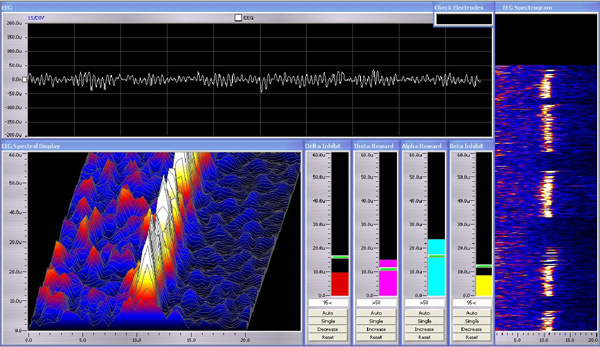
Instruments 1 is designed to for a clearer display of changes in frequencies and amplitudes over time. The raw EEG display allows us to see bursts of rhythmic activity within the 10 second record. The spectral display shows the dominant frequency of such bursts plus shifts in frequency and amplitude over about 20 seconds. Both spectral display and spectrogram display 0-20 Hz to allow a clearer definition of frequencies in the alpha and theta range. The spectrogram is like a compressed version of the spectral display that shows about 10 minutes of EEG data. We can see in this example that the alpha amplitude rises and falls every couple minutes. The amplitude shifts can also be observed in the Instruments 2 trend lines. The advantage of the spectrogram is that it also displays shifts in frequency. The immediate training band amplitudes are displayed as bars relative to their respective thresholds. The filter tool is not shown here since the frequency bands are not typically changed during an alpha-theta session, and it is easy to bring up the filter tool as needed.
EEGInfo 2 Channel Sum Alpha-Theta
The two-channel sum design works with two channels of EEG data that are added together to produce feedback on the amplitude of the combined signal. The sum of channels allows us to reward increased alpha or theta amplitudes at either site while also rewarding increased synchrony between the two sites. Our experience so far is that the two-channel sum design produces a stronger, more profound effect than one channel alpha-theta. This is not a surprise since synchronous alpha and theta activity across the hemispheres is related to more intense deep state experiences.
It is critical that the plus and minus (or active and reference) electrodes are arranged in the same order on both sides of the head as shown below.
Channel 1:
P3 = + or active
A1 = – or reference
Channel 2:
P4 = + or active
A2 = – or reference
(The ground electrode can go on either ear, not touching the other ear clip, or more simply on the scalp.)
Then (Channel 1) + (Channel 2) = (P3-A1) + (P4-A2)
And if the references are roughly equivalent (A1 =A2)
Then (Channel 1) + (Channel 2) = (P3-A1) + (P4-A2) = P3+P4
If the input to one channel is reversed, then we get (P3-A1) + (A2-P4) = P3-P4, which is the opposite of what we want. For convenience in our clinic we are wrapping the channel one and channel two electrodes separately from each other and from the ground electrode. This helps avoid mistakes and confusion when attaching electrodes.
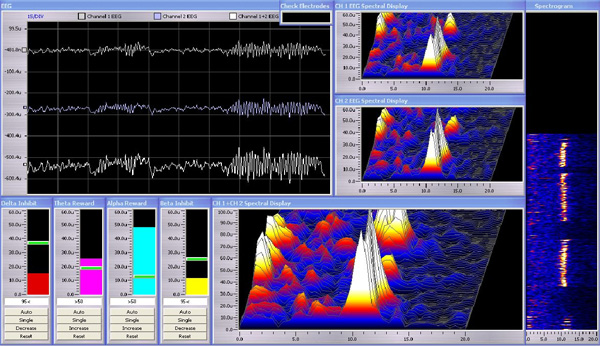
Instruments 1 displays the EEG signal and spectral display for each channel separately and for the sum of channels. We can watch bursts of activity and see where they are occurring — left or right or both synchronously. The spectrogram and threshold displays show the sum of channels EEG. Instruments 2 trend lines and AT Sounder feedback all reflect the sum of channels data — rewarding increasing amplitude and synchronous activity at both sites.
**This Item is No Longer Available – This Post is from 2006






Looks good but how do I get a copy?
New BioExplorer Deep-State Designs and Alpha-Theta Sounder Program
I already have BioExorer. Can you tell me more details about this program?
Please send me the above design
The technology has moved on, and we have also moved to a new platform. The basic design objective has, however, remained largely as before. Merely the implementation has improved, taking advantage of modern software tools and greater design freedom. We are now putting our creative energies into the Cygnet platform. The latest Alpha-Theta program offers binaural beats as an additional augment to the training. It includes various options such as verbal inductions. It also features calming visual imagery to go along with eyes-open training.